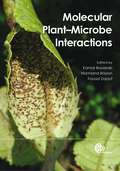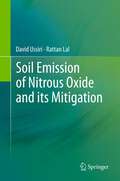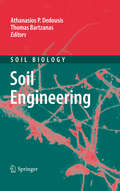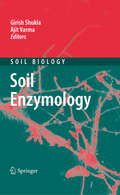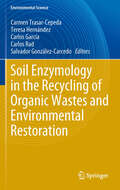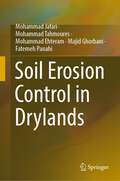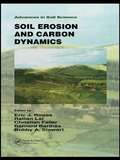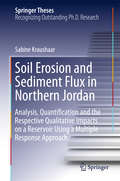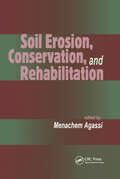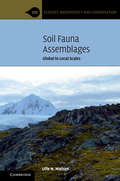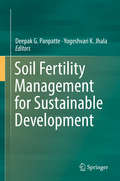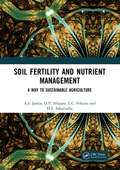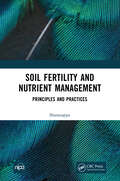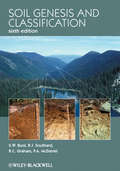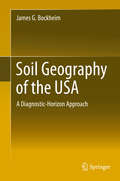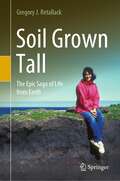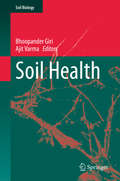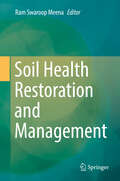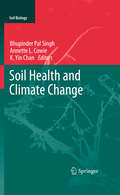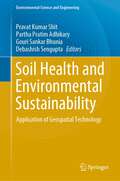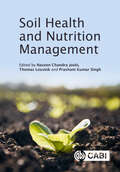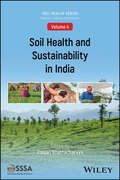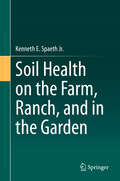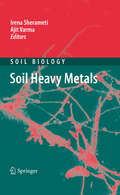- Table View
- List View
Soil Ecology and Management
by Joann Whalen Luis SampedroSoil ecology is the study of interactions between the physio-chemical components of the soil and organisms living within the soil. Humans are highly dependent upon the soil ecosystem, which provides food, fiber, fuel and ecological services, such as the recycling of atmospheric gases. It is therefore important to understand the function and nature of the soil ecosystem in order to predict and mitigate the long term consequences of present day actions. Soil Ecology and Management describes the organisms inhabiting the soil, their functions and interactions and the dimensions of human impact on the activity of soil organisms and soil ecological function. Chapters discuss basic soil characteristics and biogeochemical cycling, key soil flora and fauna, community-level dynamics (soil food webs) and the ecological and pedological functions of soil organisms. Unlike other soil biology and ecology textbooks, the authors also convey a better understanding of how human activities impact upon soil ecology in a section on ecosystem management and its effects on soil biota and provide a unique perspective on the utility of soil organisms.
Soil Emission of Nitrous Oxide and its Mitigation
by Rattan Lal David UssiriNitrous oxide gas is a long-lived relatively active greenhouse gas (GHG) with an atmospheric lifetime of approximately 120 years, and heat trapping effects about 310 times more powerful than carbon dioxide per molecule basis. It contributes about 6% of observed global warming. Nitrous oxide is not only a potent GHG, but it also plays a significant role in the depletion of stratospheric ozone. This book describes the anthropogenic sources of N2O with major emphasis on agricultural activities. It summarizes an overview of global cycling of N and the role of nitrous oxide on global warming and ozone depletion, and then focus on major source, soil borne nitrous oxide emissions. The spatial-temporal variation of soil nitrous oxide fluxes and underlying biogeochemical processes are described, as well as approaches to quantify fluxes of N2O from soils. Mitigation strategies to reduce the emissions, especially from agricultural soils, and fertilizer nitrogen sources are described in detail in the latter part of the book.
Soil Engineering
by Athanasios P. Dedousis Thomas BartzanasThe agricultural world has changed significantly during the last years. The excessive use of heavy machinery, waste disposal, the use of agrochemicals and new soil cultivation means led to severe problems, which agricultural engineers have to cope with in order to prevent soil from permanent irreversible damage. This Soil Biology volume will update readers on several cutting-edge aspects of sustainable soil engineering including topics such as: soil compaction, soil density increases, soil disturbance and soil fragmentation; soil tillage machineries and optimization of tillage tools; soil traffic and traction, effects of heavy agricultural machines, the use of robotics in agriculture and controlled traffic farming; mechanical weed control, the characterization of soil variability and the recycling of compost and biosolids in agricultural soils.
Soil Enzymology
by Ajit Varma Girish ShuklaSoil enzymes are one of the vital key mediators involved in nutrient recycling and the decomposition of organic matter and thereby in maintaining soil quality and fertility. This Soil Biology volume covers the various facets of soil enzymes, such as their functions, biochemical and microbiological properties and the factors affecting their activities. Enzymes in the rhizosphere, in forest soils, and in volcanic ash-derived soils are described. Soil enzymes covered include phosphohydrolases, lignocellulose-degrading enzymes, phenol oxidases, fungal oxidoreductases, keratinases, pectinases, xylanases, lipases and pectinases. Several chapters treat the soil enzymatic activities in the bioremediation of soils contaminated with pesticides and pollutants such as oil, chlorinated compounds, synthetic dyes and aromatic hydrocarbons. The role of soil enzymes as bioindicators is a further important topic addressed.
Soil Enzymology in the Recycling of Organic Wastes and Environmental Restoration
by Carlos García Salvador González-Carcedo Carmen Trasar-Cepeda Teresa Hernández Carlos RadSoil enzymes play a fundamental role in many soil processes such as the mineralization of organic matter, the synthesis of humic substances, the degradation of xenobiotics or the mechanisms involved in the biocontrol of plant pathogens. Their direct link with soil microorganisms gives them a key role as biomonitors of the evolution of soil quality or in the monitoring of the application of organic amendments to degraded soils. As a consequence of the importance of soil enzymes on soil processes, there is an increasing interest in their study, as well as in the application of molecular techniques as diagnostic tools.
Soil Erosion Control in Drylands
by Mohammad Jafari Fatemeh Panahi Majid Ghorbani Mohammad Tahmoures Mohammad EhteramThis book focuses on drylands such as arid, semi-arid and dry sub-humid areas where they form the main part of ecosystems, e.g., in Iran, but also around the world. Mismanagement and improper exploitation of these areas lead to more degradation day by day. Besides an introduction to the role and importance of vegetation cover in conserving soil against wind and water erosion, this book gives a scope of appropriate techniques and methods for vegetation establishment and maintenance, indicators for suitable plants selection for soil conservation, and soil erosion prevention and combat. It provides methods of soil erosion prevention and combating through the application of plants, using bioengineering systems for soil erosion control and the role of agroforestry in soil erosion prevention. This book can be helpful to those with an interest in countries with similar climates to Iran. In particular, this includes Dubai, Kuwait, Saudi Arabia, Afghanistan, and Pakistan.
Soil Erosion and Carbon Dynamics (Advances In Soil Science Ser. #Vol. 15)
by Eric J. RooseThe most complete, nonpartisan source of information on this hot agronomic topic available today, this book brings together a diverse group of papers and data to resolve the debate between sedimentologists and soil scientists and agronomists over whether the effects of soil erosion on carbon and atmospheric CO2 is beneficial or destructive. Divided into four sections, it offers data on how soil erosion affects soil, water, and air quality. Topics include mineralization rate, inundation, sediment deposition, and global warming potential, as well as carbon dioxide, methane, and nitrous oxide emissions, and the implications of soil erosion on the global carbon cycle and carbon budget.
Soil Erosion and Sediment Flux in Northern Jordan
by Sabine KraushaarThis book combines new quantitative erosion measurement methods with a geochemical fingerprint and a model-based approach to measure erosion and sediment flux in the Wadi Al-Arab, a Mediterranean to semi-arid catchment in northwest Jordan. The outcomes reveal the local importance of soil erosion and sediment yield in connection with sedimentation and pollution of surface water bodies, propose managed aquifer recharge strategies that focus on in-channel constructions, and can be used to support local soil management strategies. In Jordan, one of the most water scarcity-affected countries in the world, erosion and sedimentation negatively impact integrative water resource management projects, such as water reservoirs and groundwater recharge basins. This book combines a multiple-response approach with new qualitative methods, such as olive mound measurements and OSL dating of Roman cistern sediments, to obtain long-term average erosion rates in the Mediterranean to semi-arid Wadi Al-Arab catchment in northwest Jordan. The implementation and enhancement of a geochemical sediment fingerprint of the reservoir sediments helped to provide new insights on sediment connectivity. Lastly, the outcomes were compiled and tested in the SedNet model, which provides a more holistic view of the results at the catchment scale and can effectively complement local management strategies.
Soil Erosion, Conservation, and Rehabilitation
by Agassi,Discusses the latest information regarding the processes and mechanisms responsible for runoff and erosion by water in arable lands--detailing state-of-the-art water and soil conservation methods. Elucidates the rehabilitation of agricultural lands depleted by human activity.
Soil Fauna Assemblages: Global to Local Scales (Ecology, Biodiversity and Conservation)
by Uffe N. NielsenThis volume provides a modern introduction to the soil fauna and their contributions to ecosystem function, the mechanisms that structure soil fauna assemblages from local to global scales, and the potential impacts of global change on soil fauna assemblages and through this ecosystem function. Wanting to be an accessible primer, this book is a high level overview of current knowledge rather than a detailed tome of all existing information, with emphasis being placed on key findings and general patterns. It focuses on the soil fauna but contextualizes these assemblages in relation to the microbial assemblages belowground and the vegetation aboveground. It is clear that our knowledge of soil fauna assemblages is ever increasing, but there is still a lot to discover. Key areas of research are highlighted, with particular reference to the future of soil fauna assemblages.
Soil Fertility Management for Sustainable Development
by Deepak G. Panpatte Yogeshvari K. JhalaSoil fertility is the backbone of agricultural systems and plays a key role in determining food quantity and quality. In recent decades, soil fertility has decreased due to indiscriminate use of agrochemicals, and nations around the globe are now facing the challenge of increasing food production while sustainably maintaining soil fertility. Written by leading international scientists in the field, this book explores soil fertility management strategies, including agronomic, microbiological and soil-science based strategies. Highlighting the practices that can be incorporated into organic farming and discussing recent advances, it is a valuable resource for researchers wanting to broaden their vision and the scope of their investigations.
Soil Fertility and Nutrient Management: A Way to Sustainable Agriculture
by A.S. Jadeja D.V. Hirpara L.C. Vekaria H.L. SakarvadiaThe book entitled Soil Fertility and Nutrient Management is a compilation work and most of the information was farmed very critically covering all the main topics of plant nutrition. The book will be serve as useful reference to students, teachers, researchers scientists, policy makers and other interested in soil science, agronomy, crop science, environmental sciences and agriculture. Note: T&F does not sell or distribute the Hardback in India, Pakistan, Nepal, Bhutan, Bangladesh and Sri Lanka.
Soil Fertility and Nutrient Management: Principles and Practices
by SharanappaUnderstanding of the dynamics of plant nutrients in the soil provides scientific basis for efficient nutrient management. Soil organic matter not only provides the nutrients required by the crop but also improve the biological and physical properties of the soil. This book collects and discusses information on production and management of organic manures, biofertilizers, integrated nutrient management in cropping systems and nutrient management in problematic soils. Print and electronic editions not for sale in South Asia (India, Sri Lanka, Nepal, Bangladesh, Pakistan, Afghanistan and Bhutan).
Soil Genesis and Classification
by Stanley W. Buol Randal J. Southard Robert C. Graham Paul A. McDanielSoil Genesis and Classification, Sixth Edition, builds on the success of the previous editions to present an unparalleled resource on soil formation and classification. Featuring a color plate section containing multiple soil profiles, this text also includes information on new classification systems and emerging technologies and databases with updated references throughout. Covering the diverse needs of both the academic and professional communities, this classic text will be a must have reference for all those in soil science and related fields.
Soil Geography of the USA
by James G. BockheimSince 1980, our understanding of the factors and processes governing the distribution of soils on the Earth's surface has increased dramatically, as have the techniques for studying soil patterns. The approach used in this book relies on the National Resources Conservation Service databases to delineate the distribution of each of the eight diagnostic epipedons and 19 subsurface horizons, to identify the taxonomic level at which each of these horizons is used, to develop an understanding of the role of the factors and processes in their formation and to summarize our latest understanding of their genesis. A chapter is devoted to each diagnostic horizon (or combined horizons). This book is intended to serve as a textbook in soil geography, a reference book for geographers, ecologists and geologists and a tool for soil instructors, landlookers, mappers, classifiers and information technologists.
Soil Grown Tall: The Epic Saga of Life from Earth
by Gregory J. RetallackThis book is designed as an easy night's read and introduction to fossil soils and the relatively new disciplines of Paleopedology and Astropedology. It includes line art and color illustrations to visualize the topic for the informed layperson or interested colleagues. It provides comprehensive information on paleosols, which are soils of the past providing a variety of clues to the evolution of life and climate on Earth and deals with topics such as the evolution of grassland ecosystems, mass extinction of the Late Permian and origin of life, all viewed from the perspective of the fossil record of soils. This turns out to be a refreshing new perspective of wide interest.
Soil Health (Soil Biology #59)
by Ajit Varma Bhoopander GiriThis book gathers the latest insights into soil health and its sustainability, providing an up-to-date overview of the various aspects of soil quality and fertility management, e.g., plant-microbe interactions to maintain soil health; and the use of algal, fungal and bacterial fertilizers and earthworms for sustainable soil health and agricultural production.It first discusses the past, present, and future scenarios of soil health, and then explores factors influencing soil health, as well as the consequences of degradation of soil health for sustainable agriculture. Lastly it highlights solutions to improve and maintain soil health so as to achieve greater productivity and sustainability without damaging the soil system or the environment.Soil health is defined as the capacity of a soil to function within ecosystem frontiers, to sustain biological productivity, to maintain environmental quality and to promote plant, animal and human health. Soil health is established through the interactions of physical, chemical and biological properties, e.g., soil texture, soil structure, and soil organisms. Healthy soil provides adequate levels of macro- and micronutrients to plants and contains sufficient populations of soil microorganisms. As a result of the increasingly intensified agriculture over the past few decades, soils are now showing symptoms of exhaustion and stagnating or declining crop yields. Exploring these developments as well as possible solutions based on holistic and sustainable approaches, this book is a valuable resource for researchers in the area of soil and environmental science, agronomy, agriculture, as well as students in the field of botany, ecology and microbiology.
Soil Health Analysis, Set (ASA, CSSA, and SSSA Books)
by Douglas L. Karlen Diane E. Stott Maysoon M. MikhaVolume 1 briefly reviews selected &“Approaches to Soil Health Analysis&” including a brief history of the concept, challenges and opportunities, meta-data and assessment, applications to forestry and urban land reclamation, and future soil health monitoring and evaluation approaches.Volume 2 focuses on &“Laboratory Methods for Soil Health Analysis&” including an overview and suggested analytical approaches intended to provide meaningful, comparable data so that soil health can be used to guide restoration and protection of our global soil resources.
Soil Health Restoration and Management
by Ram Swaroop MeenaMeeting the food requirements of an ever-increasing population is a pressing challenge for every country around the globe. Soil degradation has a negative impact on food security by reducing the cultivated land areas, while at the same time the world population is predicted to increase to 9.2 billion in 2050. Soil degradation adversely affects soil function and productivity and degraded soils now amount to 6 billion ha worldwide. The major factors are salinization, erosion, depletion of nutrients due to exhaustive agricultural practices and contamination with toxic metal ions and agrochemicals, which reduces the activity of soil microbe. In addition, poor soil management also decreases fertility. As such, measures are required to restore the soil health and productivity: organic matter, beneficial microorganisms and nutrient dynamics can all improve the physical, chemical and biological properties of soil. Understanding the role of soil health restoration and management in sustainability and nutritional security calls for a holistic approach to assess soil functions and examine the contributions of a particular management system within a defined timescale. Further, best management practices in cropping systems are important in ensuring sustainability and food and nutritional security without compromising the soil quality and productivity potential. Rational soil management practices must allow environmentally and economically sustainable yields and restoration of soil health.
Soil Health and Climate Change
by Bhupinder Pal Singh Annette L. Cowie K. Yin Chan"Soil Health and Climate Change" presents a comprehensive overview of the concept of soil health, including the significance of key soil attributes and management of soil health in conventional and emerging land use systems in the context of climate change. Starting with a review of the physical, chemical and biological indicators of soil health and their significance for monitoring the impacts of climate change, this book then focuses on describing the role of soil structure, pH, organic matter, nitrogen, respiration and biota in sustaining the basic functions of soil ecosystems, and their anticipated responses to climate change. Further topics include the management of cropping, pastoral, and forestry systems, and rehabilitated mine sites, with a focus on mitigation of and adaptation to climate change impacts. Finally, the opportunities and potential risks of organic farming, biochar and bioenergy systems, and their ability to sustain and even enhance soil health, are discussed.
Soil Health and Environmental Sustainability: Application of Geospatial Technology (Environmental Science and Engineering)
by Debashish Sengupta Gouri Sankar Bhunia Pravat Kumar Shit Partha Pratim AdhikaryThis book demonstrates the measurement, monitoring, mapping and modelling of soil pollution and land resources. This book explores state-of-the-art techniques based on open sources software & R statistical programming and modelling in modern geo-computation techniques specifically focusing on the recent trends in data mining/machine learning techniques and robust modelling in soil resources. Soil and agricultural systems are an integral part of the global environment and human well‐being, providing multiple goods and services essential for people worldwide and crucial for sustainable development. Soil contamination is an environmental hazard and has become a big issue related to environmental health. The challenge of the twenty-first century is to reduce the contaminant load and bring it to below permissible level. The contamination is not only a problem affecting local environments at the place of occurrence but also spreading to other regions because of easy transportation of pollutants. This leads to direct and indirect contamination of land and aquatic systems, surface water and groundwater, inducing significant risks for natural ecosystems. In this context, the spatial modelling, prediction, efficient use, risk assessment, protection and management of soil resources in the agriculture system are the key to achieving sustainable development goals and ensuring the promotion of an economically, socially and environmental sustainability future. The aim of this book on soil contaminants and environmental health: application of geospatial technology is to identify the soil and sediment quality, sources of contaminants and risk assessment and focuses on the decision-making and planning point of view through GIS data management techniques. This book covers major topics such as spatial modelling in soil and sediments pollution and remediation; radioactive wastes, microbiology of soil and sediments, soil salinity and sodicity, pollution from landfill sites, soil erosion and contamination from agricultural activities, heavy metal pollution and health risk; environmental impact and risk assessment, sustainable land use, landscape management and governance, soil degradation and risk assessment, agricultural soil pollution, pollution due to urban activities, soil pollution by industrial effluents and solid wastes, pollution control and mitigation in extreme environments. The content of this book is of interest to researchers, professionals and policy-makers whose work is in soil science and agriculture practices. The book equips with the knowledge and skills to tackle a wide range of issues manifested in geographic data, including those with scientific, societal and environmental implications.
Soil Health and Nutrition Management
A major challenge for agriculture and future crop production is the deterioration in soil health and fertility. We have large areas of barren land across the globe with degraded soil which can only be made fertile by applying proper nutrition and soil health management practices. It is crucial to protect soil health in order to feed the world's ever-growing population. Healthy soil is a dynamic ecosystem containing microbes that aid in the breakdown of organic materials and minerals, increasing the availability of plant nutrients (nutrient recycling) and enhancing soil quality and crop output. Healthy soil also helps mitigate the impact of climate change by maintaining nutrients and sequestering atmospheric carbon. This book summarizes the numerous components of soil health management including cutting-edge technologies such as genome editing and rhizospheric engineering, together with conventional techniques for preserving soil nutrients.
Soil Health and Sustainability in India (ASA, CSSA, and SSSA Books)
by Douglas L. KarlenAn in-depth resource that explores soil health issues in India Soil Health and Sustainability in India delivers a comprehensive overview of the problems surrounding soil health in the different regions of India, The book documents both soil degradation and soil health improvements in agricultural systems. It looks at how to mitigate soil health hazards such as waterlogging, acidity, soil salinity, and soil compaction. It also discusses soil health constraints in different ecoregions and suggests potential solutions for enhancing environmental and socio-economic issues regarding soil in the sub-continent. Past and current soil conservation programs in India are reviewed in detail to better understand how production and policy-related issues affect soil and water conservation. Incentives needed to address the most critical problems are also discussed. Encouraging results associated with watershed-scale soil and water conservation programs together with effective interventions to reduce land degradation and improve productivity are covered. Finally, pervasive physical, chemical, and biological soil health constraints present in different ecoregions are also discussed in detail. Soil Health and Sustainability in India explores Deforestation and removal of natural vegetation through overgrazing and land use changeDepletion of organic matter in soil, by excessive tillage, heavy machinery used for harvesting, and lack of adequate soil conservation measuresSalt pollution from the textile, glass, rubber, animal hide processing, metal processing, and pharmaceutical industriesSoil erosion by water, wind, and cyclonic storms, and different types of soil, including brown and red hill soils, alluvium-derived soils, lateritic soils, and podzolic soils Soil Health and Sustainability in India is a timely resource on soil health in India. It is aimed at soil scientists, agronomists, industry professionals, and students of soil health, crop science, and agriculture seeking to understand India’s soil conservation problems and find solutions to improve soil health in such a regionally diverse country.
Soil Health on the Farm, Ranch, and in the Garden
by Kenneth E. Spaeth Jr.This book explores the importance of soil health in croplands, rangelands, pasturelands, and gardens, and presents new methods and technologies for assessing soil dynamics and health in these different land types. Through perspectives of agriculture, soil management, and ecological sustainability, the book provides accurate and up-to-date information on soil health assessment and maintenance that is often missing from current literature on conservation and environmental management and preservation. The book is written in a clear and concise format, and will appeal to non-scientists interested in soil health, as well as professional farmers, ranchers and gardeners. The book begins by discussing soil health from a historical perspective, and in terms of how it is covered in the news currently. Then the author addresses the ecological implications of soil health in farming, ranching and gardening, and comprehensively details the physical, chemical and biological properties of soil as they apply in various land types. The book then examines soil health assessment using new diagnostic and analytic technologies, and how these new innovations will be necessary going forward to maintain and improve soil health.
Soil Heavy Metals
by Ajit Varma Irena SherametiHuman activities have dramatically changed the composition and organisation of soils. Industrial and urban wastes, agricultural application and also mining activities resulted in an increased concentration of heavy metals in soils. How plants and soil microorganisms cope with this situation and the sophisticated techniques developed for survival in contaminated soils is discussed in this volume. The topics presented include: the general role of heavy metals in biological soil systems; the relation of inorganic and organic pollutions; heavy metal, salt tolerance and combined effects with salinity; effects on abuscular mycorrhizal and on saprophytic soil fungi; heavy metal resistance by streptomycetes; trace element determination of environmental samples; the use of microbiological communities as indicators; phytostabilization of lead polluted sites by native plants; effects of soil earthworms on removal of heavy metals and the remediation of heavy metal contaminated tropical land.
